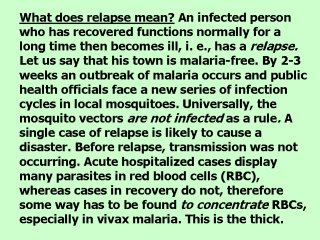 |
What
is a thick ‘n’ thin? The ordinary blood slide is a thin, and a dried pool of blood on
a slide lysed in water is a thick. The heart of an eradication campaign is a thick. Perhaps
the case that will but has not relapsed can be located using a thick. The relapsed case
means that its local mosquitoes will soon be infected. Diagnosing the kind of malaria from
blood slides is of course vitally important, BUT the chances are that that slide came from
an acute hospital case of malaria rather than an asymptomatic field case. In the
epidemiology of field work, we might be looking for positives that can relapse. Then we
need the thick first, not the thin. |
